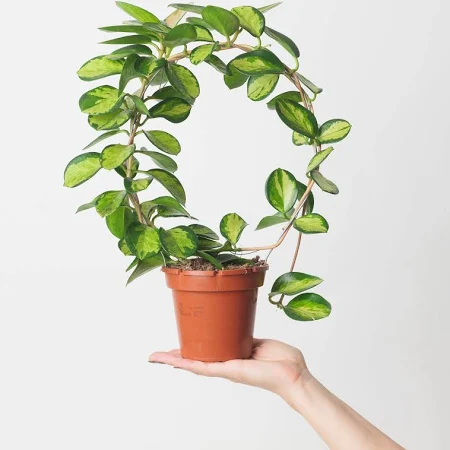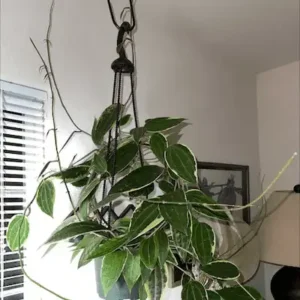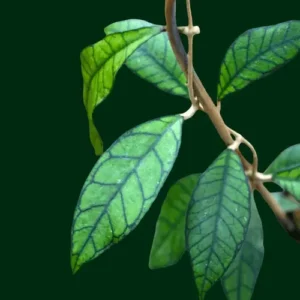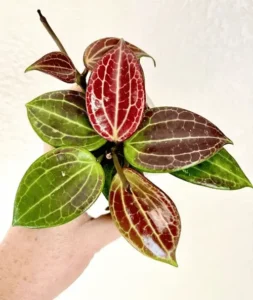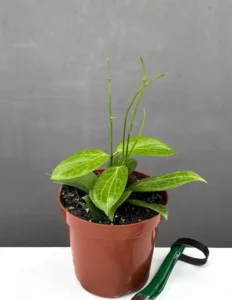Introduction
Whether you’re a beginner or an experienced plant lover, the best Hoya plants are sure to captivate with their charm and versatility. Moreover, the pre-eminent hoya plants provide aromatic blooms and stunning looks. A list of these hoya plants is as follows.
| Hoya Carnosa | Hoya Carnosa ‘Krimson Princess’ | Hoya Shepherdii | Hoya Australis |
| Hoya Kerrii | Hoya Punicalyx (storyteller plant) | Hoya Burtoniae | Hoya Compacta ‘Hindu Rope’ |
| Hoya Obovata | Hoya Wayetii | Hoya Linearis | Hoya Carnosa ‘Krimson Queen’ |
Hoya Carnosa
Scientific name: hoya carnosa
Common name: wax plant, wax flower, porcelain flower
Light requirements: bright, indirect light
Temperature requirements: 60°F and 85°F(16°C – 29°C)
Propagation: by seeds, by layering, by stem cutting
Description
Hoya carnosa, commonly known as the wax plant or porcelain flower, is a popular houseplant known for its thick, waxy leaves and fragrant, star-shaped flowers. It belongs to the Apocynaceae family and is native to East Asia and Australia. It is a popular houseplant that is cultivated for its fragrant flowers and waxy leaves.
Facts
-Hoya carnosa belongs to the Apocynaceae family and mainly originated from Thailand. It’s a vining succulent and flowering plant. It is commonly found in Eastern Asia and Australia, Queensland, East India, Taiwan, Malaysia, Vietnam, etc.
-It is a plant with low maintenance. Summer and spring are the best seasons for the growth of this beautiful houseplant. This plant has a unique and elegant appearance. It has shiny green leaves with red stems that reach up to 3 inches tall. That is why it’s called a trailing vine. Hornets, bees, butterflies, and other pollinators are drawn to the park due to its enormous blooms.
Benefits
Medicinal benefits
-It is very beneficial for human health as it has many antibacterial and antioxidant properties that make it very useful for traditional medicines.
Uses as a decorative houseplant
-It is also good for skin treatments. It is also used as a decorative houseplant.
Hoya kerrii
Scientific name: hoya kerrii
Common name: Sweetheart Hoya, Heart-shaped Hoya, Heart Leaf, Valentine Hoya, Valentine Wax Plant
Light requirements: bright, indirect light
Temperature requirements: 60°F and 85°F(16°C – 29°C)
Propagation: by stem cutting, by leaf cutting, by ziplock method, by Sphagnum Moss, by Passive Hydroponics with Perlite
Description
Hoya kerrii , commonly known as the sweetheart plant, valentine hoya, or heart-leaf hoya, is a popular succulent vine known for its distinctive heart-shaped leaves. It’s often given as a romantic gift due to the unique shape of its leaves. It is also sometimes named a lucky-heart plant.it is a thick, succulent-like tropical vine that is easily identified by its heart.
Facts
-The most striking fact of Hoya kerrii is its thick, fleshy, heart-shaped leaves. These leaves are usually dark green, although variegated varieties with white or yellow margins are also available.
-Hoya kerrii has a fishtail leaf shape which makes it more romantic and beautiful. Hoya kerrii is a slow-growing vine that can be grown as a trailing or climbing plant. It’s often sold as a single leaf cutting, which can root and eventually grow into a full plant, although the process is slow.
-Like other Hoya species, Hoya kerrii can produce clusters of small, star-shaped flowers known as umbels. The flowers are usually creamy white with a pink or red center and are fragrant, especially in the evening. However, it may take several years before a young plant blooms. it is one of the best hoya plants.
Benefits
Unique appearance and resilience
-Hoya kerrii is adored for its unique appearance, symbolism, and ease of care. It has low maintenance and resilience.
Natural air purifier
-It is a natural air purifier with many health benefits, such as releasing oxygen and absorbing poisons. It has unique Heart-shaped Leaves, aesthetic appeal, flexible growth settings, and positioning. It has beautiful wax-like flowers, Fragrance, longevity, and growth potential.
Symbol of love and friendship
-It is a symbol of love and friendship. it has a cultural significance, displaying ideas and historical uses. it is a stress-relieving Aesthetics. It is easy to propagate.
Hoya Obovota
Scientific name: Hoya obovata
Common name: Hoya obovata, wax plant
Light requirements: bright, indirect light
Temperature requirements: 60°F and 85°F(16°C – 29°C)
Propagation: by stem cuttings in soil and water
Description
Hoya obovata is a popular species of the Hoya genus, known for its attractive, round leaves and ease of care. Like other Hoyas, it is a vining plant and is often grown as a houseplant due to its ornamental vegetation and occasional blooms. Hoya obovota is identified by its large, deep green silver-speckled oval leaves.
Facts
-Hoya obovata is a climbing or trailing vine, making it ideal for hanging baskets, trellises, or being trained to grow along supports. It is a fast-growing Hoya compared to others in the genus.
-The plant produces clusters of small, star-shaped flowers, typically pink or pale purple with a darker center. The flowers are fragrant and produce a sweet, nectar-like substance. Hoya obovata is known for its reliable blooming when given proper care.
-Hoya obovata is cherished by plant enthusiasts for its beautiful, robust leaves and its ability to thrive with minimal care. It’s a great choice for both beginners and experienced plant lovers looking for a striking, low-maintenance addition to their collection. Each hoya obovata has a unique personality, no two plants have the same pattern.
Benefits
Aesthetic appeal
-Hoya obovata promotes home decor with aesthetic appeal and a multi-sensory experience. Put another way, it’s a natural icebreaker.
Easy to care
-It is easy to care for with moderate light, temperature, water, and humidity needs. It is also easy to grow and prune. It has a non-toxic nature. This plant also symbolizes love and prosperity.
Dynamic display
-Hoya obovata leaf variation is similar to nature’s creative expression. It has a dynamic display, every leaf growing has a surprise for the plantar.
Hoya Carnosa, ‘Krimson Princess’
Scientific name: hoya carnosa
Common name: wax flower, porcelain flower, hoya Rubra
Light requirements: bright, indirect light
Temperature requirements: 60°F and 85°F(16°C – 29°C)
Propagation: by stem cutting
Description
Hoya carnosa, ‘Krimson Princess’ has vivid green leaves that are accented with creamy white to pink variegation in the centers, which contrasts with the green borders. It’s originally from East Asia and Australia. The species of Hoya carnosa thrives in tropical and subtropical environments, clinging to trees and rocks in its natural habitat. This is a showy and evergreen plant.
Facts
-Hoya carnosa, ‘krimson princess’ is a succulent vine that can grow upwards gracefully with the support from hanging baskets. It is a stem-rooting climber.
-It is adaptable, developing as an indoor potted plant and an outdoor enduring plant in warm climates.
-This plant is renowned for its beautiful star-shaped flower blooming in clusters. these waxy, porcelain-like flowers are red-centered with pale pink and emit a sweet fragrance in the evening especially. Flowering may take several years to bloom.
Benefits
Used in Mediterranean gardens
-Hoya carnosa, ‘krimson princess’ is used as a hanging basket, container, and paved area of a garden. It is mainly used in Mediterranean gardens.
Natural air purifier
-It is a natural air purifier, that maintains a good quality of indoor environment conditions by removing pollutants.
Hoya Pubicalyx (storyteller plant)
Scientific name: hoya pubicalyx
Common name: pink silver, porcelain flower, silver pink vine
Light requirements: bright, indirect light
Temperature requirements: 60°F and 85°F(16°C – 29°C)
Propagation: by stem cutting
Description
Hoya pubicalyx is a captivating species among the genus of Hoya. It is widely appreciated for its stunning flowers and decorative foliage. It is native to the Philippines and is sometimes confused as a hoya carnosa. this wax plant is an epiphytic herbaceous perennial in the dogbane family (Apocynaceae) It is also called a succulent vine. Its dark green leaves are subtly mottled with grayish, silvery specks that look quite beautiful.
Facts
-It grows in a tropical rainforest.
-It is also kept as a houseplant in a temperature climate and can be found in variegated forms in nurseries.
-This species has the most attractive silver-flecked leaves and aromatic showy flowers that make a garden full of beauty and adversity.
Benefits
Low maintenance plant
-It is a low-maintenance plant. It is a natural air purifier and plays the role of a workhouse for your lungs.
Beautiful foliage
-It foliage in a beautiful way as it adds silver to your greenery. It has different growing options, so you can adapt it to space and style easily. It is a plant with low light tolerance, beneficial for only low sunny apartments.
Easy to care for and propagate
-It is easy to care for and propagate. It is a symbol of love, luck, and perseverance. it is considered a storyteller plant.
Hoya Wayetii
Scientific name: hoya wayetii
Common name: wayetii wax plant
Light requirements: bright, indirect light
Temperature requirements: 60°F and 85°F(16°C – 29°C)
Propagation: by stem cuttings in water, or soil
Description
Hoya wayetii is an epiphytic succulent that tends to trail. This species, which prefers dampness, creates lovely tiny clusters of mauve flowers.it is sometimes confused with Hoya kentiana or Hoya shepherdii.
Facts
-The distinctive feature of this plant is its thick, deep green leaves, which, with sufficient light, turn crimson at the edges. Seek for the variegated variety, whose leaves have a remarkable yellow-white pattern. It has a vining growth habit.
-They’re ideal for arranging on shelves or hanging baskets because of their trailing habit. If let to develop, the tendrils can attain a maximum length of three feet.
-The Hoya wayetii is a humidity-loving plant that thrives in well-lit bathrooms. This plant is known for its adaptability.
Benefits
Natural air filter plant
-It is a natural air filter plant. its leaves work tirelessly to remove toxins from the environment.
Reflects cultural heritage and strength
-It reflects cultural heritage and strength. It is a symbol of love, luck, and resilience. It is easy to care for and propagate. Any area is made more elegant by its trailing, delicate leaves.
Hoya Shepherdii
Scientific name: hoya shepherdii
Common name: string bean hoya, hoya shepherdii
Light requirements: bright, indirect light
Temperature requirements: 60°F and 85°F(16°C – 29°C)
Propagation: by stem cuttings in water, soil, or vermiculite
Description
A species of flowering plant in the Hoya genus that is indigenous to Assam and the Eastern Himalayas is called Hoya shepherdii. It is well-known for having long, thin leaves that, at first glance, resemble green beans and are related to Hoya kentiana and Hoya wayetii.
Facts
-This hoya plant is the best choice for indoor gardening. This is a plant with low maintenance.
-This is a succulent, vine plant best known for its fragrant flowers. This is also called a string bean hoya due to its long, thin, and succulent leaves. And turning yellow. Keep the plant in enough sunlight otherwise the leaves will drop off
Benefits
Easy to grow
-This plant is easy to grow, resilient, and useful for beginners.
Vestige display
-It has a vestige display, ideal for hanging baskets due to its long narrow, and unique leaves.
Hoya Burtoniae
Scientific name: Hoya sp aff. burtoniae
Common name: Hoya Burtoniae
Light requirements: bright, indirect light
Temperature requirements: 60°F and 85°F(16°C – 29°C)
Propagation: by stem cuttings
Description
The Hoya Burtoniae hanging plant requires little maintenance, the less you do, the better. The long, thin stems can trail over the edge of a pot or basket, or they might climb it. The leaves of this plant have pale undersides and are succulent, meaty, and green. Hoyas are quite laid back and would make a wonderful present for someone leading a busy lifestyle.
Facts
-This beautiful houseplant would be perfect for a bathroom or kitchen.
-In higher light, the leaves of Burtoniae may have a reddish tint, and each leaf may have a dark ring encircling its edge.
Benefits
Pet-friendly
-This houseplant is easy to care for, pet-friendly, useful for hanging, and a natural air purifier powerhouse.
A rare plant
-It is also a rare and unusual hoya plant for indoor gardening.
Hoya Linearis
Scientific name: Hoya linearis
Common name: Wax plant, porcelain flower, miniature wax plant, hoya carnosa,waxvine.
Light requirements: bright, indirect light
Temperature requirements: 60°F and 85°F(16°C – 29°C)
Propagation: by stem-cuttings, by using a cloche or heating mat(available on Amazon)
Description
Hoya linearis is a rare hoya, native to Northern India’s Himalayas. Hoya linearis does not climb as much as other plants in the genus. It grows instead in the cracks and nooks of trees, hanging lovely from their limbs.
Facts
-The leaves are narrow, tiny, and have a faint fuzz covering them. Blooming in clusters, these white, star-shaped flowers have a lovely lemon scent.
-It is reputed to be one of the most difficult hoyas to cultivate. Although it is extremely sensitive to overwatering, it must be kept in a humid atmosphere.
-A barrage of soft and lumpy tendrils makes the linear porcelain plant another trailing triumph for hoyas.
–Hoya linearis is indigenous to the tropical monsoon environment, which is a more specialized form of tropical climate.
Benefits
Elegant appearance
-It has an elegant appearance and is easy to care for.
Useful for indoor space
-It is a wonderful addition to any indoor space.
Hoya Australis
Scientific name: Hoya australis
Common name: wax vine or common wax flower
Light requirements: bright, indirect light
Temperature requirements: 60°F and 85°F(16°C – 29°C)
Propagation: by stem cuttings
Description
Hoya australis is a type of hoya plant that is best known for its fragrant white flowers, rounded oval-shaped leaves, and long climbing vines.it is one of the species among hoyas.it is mostly found in eastern and northern Australia.
Facts
-This houseplant is easy to grow, moderately vigorous climbing species.
-It is also known as waxvine or common waxflower due to its waxy leaves.
-It has Thick, almost round dark green leaves, particularly felted on the underside and measuring up to 90mm across.
-This plant is also a greenhouse-grown which means it needs to be coveted and filter light.
-Its green leaves have a splash of color, with a bright yellow and softer green coming from the center of each leaf.
Benefits
Interesting form
-Fans of hanging plants often choose hoya australis because of its interesting form, which resembles a curtain.
The extra thrill of witnessing
-One of the main draws to having this plant is the extra thrill of witnessing, its incredibly bizarre waxy blossoms.
Non-toxic plant
-Hoya australis is a non-toxic plant, not harmful to animals and humans. It is pet-friendly.
Hoya Carnosa Compacta ‘Hindu Rope’
Scientific name: Hoya carnosa
Common name: Hindu rope plant, Porcelain flower, Krinkle Kurl, Wax plant
Light requirements: bright, indirect light
Temperature requirements: 60°F and 85°F(16°C – 29°C)
Propagation: by stem cuttings
Description
Hoya hindu rope- hoya compacta is a curly – leafed version of the more common hoya carnosa.This simi- succulent, vine-like species is best known for its waxy foliage. This houseplant has beautiful flowers with curling vine-like leaves.
Facts
This one-of-a-kind Hoya won’t require much of your time. Although it may survive in dim light, it will thrive in bright, warm light. Don’t water your Hoya Carnosa Compacta too much because it wants to be dry. Regular spring fertilization will help create gorgeous, dark chocolate-scented wax blossoms that resemble globes. This houseplant takes time to grow and the gardener needs to be patient. It is one of the best hoya plants.
Benefits
Leaves
The leaves of this houseplant are waxy, wrapped, and tightly packed along the hanging stems. One of the most striking features of this is its unique color, shape, texture, and curly leaves. These curly leaves give it a unique appearance. Another striking feature is its helix and rope-like leaves arranged in opposite pairs.
Flowers
Like other hoyas, this plant also produces star-shaped flowers that make it a charming houseplant in the garden.
Troubleshooting
Turning the leaves yellow
Overwatering is frequently the cause of yellow leaves, so be careful to let the top half of the soil completely dry out in between waterings to prevent water from becoming caught in the twisted leaves.
Hoya Carnosa ‘Krimson Queen’
Scientific name: Hoya carnosa, ‘krimson queen’
Common name: wax plant, wax vine, porcelain flower, hanging plant, multicolored leaves plant
Light requirements: bright, indirect light
Temperature requirements: 60°F and 85°F(16°C – 29°C)
Propagation: by stem cuttings
Description
Hoya carnosa ‘krimson queen’ is a houseplant that is attractive and low maintenance with colorful vegetation and fragrant pink blooms. its thick succulent foliage has a dark blue-green center edge in pink or white.new leaves are often very bright pink and some leaves can be entirely white.
Facts
Leaves
-This stunning plant has the most distinctive feature, heart-shaped leaves with a pointed tip as well as a combination of green and creamy-white patterns that will catch your eye
Striking variegated foliage
-It is best known for its striking variegated foliage. The green leaves with creamy white and pink shades make a beautiful contrast.
The most popular species among hoyas
-It is a cultivar of the hoya carnosa, the most popular species among hoyas. The leaves of this popular variety are most famous for their variegation.
Benefits
Low maintenance plant
It is a low-maintenance plant with air-purifying abilities.
Suitable for indoor gardening
It is suitable for any home environment.It has diversified leaves which adds a color touch to any indoor gardening.
FAQs What is the easiest Hoya to grow? Hoya australis is the easiest plant to care for and grow. It has beautiful decorative foliage used as a hanging basket. It has its mind as compared to other hoyas. Which is the best Hoya? Hoya carnosa, commonly known as the wax plant or porcelain flower, is a popular houseplant known for its thick, waxy leaves and fragrant, star-shaped flowers. It is a popular houseplant that is cultivated for its fragrant flowers and waxy leaves. Hornets, bees, butterflies, and other pollinators are drawn to the park due to its enormous blooms. Which Hoya blooms the most? Hoya latifolia blooms in a vast amount. Its flowers have variations of colors that make it more special among all hoyas. Which Hoya is fast growing? Hoya carnosa as a climber plant grows faster as compared to other compact grower plants such as hoya kerrii. It is a fast-growing vine. |
Conclusion
Hoya plants, with their remarkable diversity and unique beauty, are among the best choices for indoor gardening enthusiasts. From the striking foliage of the Hoya kerrii to the delicate, fragrant blooms of Hoya carnosa, these plants offer both aesthetic appeal and relatively easy care requirements. Their ability to thrive in indirect light and their resilience to occasional neglect makes them ideal for beginners and seasoned plant lovers alike. Whether you seek an exotic addition to your collection or a low-maintenance companion, Hoya plants provide a rewarding and delightful experience for any home or garden.

